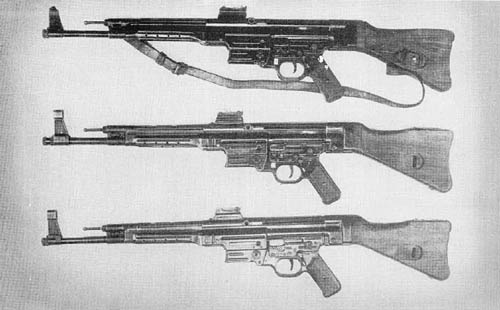 7.92 Submachine Gun: Top. M. P. 43; Center. M. P. 43/1; Bottom, M. P. 44
7.92 Submachine Gun: Top. M. P. 43; Center. M. P. 43/1; Bottom, M. P. 44
The German M. P. 43 is an automatic, air-cooled, gas-operated, magazine-fed shoulder weapon, firing from a closed bolt and a locked breech. Provision is made for both full-automatic and semi-automatic fire. For full-automatic fire, the trigger must be held back until all rounds in the magazine have been fired; for semi-automatic fire, the trigger must be released after each round. However, German official sources say that full automatic fire will be used only in emergency.
Despite the fact that it is of cheap construction, made chiefly of steel stampings, the M. P. 43 is a very serviceable weapon. It is believed that the gun was developed from the 7.92 mm M. Kb. 42 (machine carbine 42) inasmuch as the general design is quite similar, and the same type of ammunition is used. However, the M. P. 43 has a shorter barrel and gas cylinder, and has no bayonet as does the M. Kb. 42.
The receiver, frame, gas cylinder, jacket, and front sight hood are made from steel stampings. As all pins in the trigger mechanism are riveted in, it cannot be disassembled, although a complete trigger assembly may be very quickly inserted. The gas piston assembly, bolt, hammer, barrel and gas cylinder are machined parts.
The gas piston assembly consists of a piston, piston rod, and slide which appear to be machined from one piece with a stamped handle inserted. The stock and pistol grips are of low grade wood. The curved magazine is inserted from the bottom, and the fired cartridge cases are ejected on the right.
The various models of this weapon, including the M. P. 43, M. P. 43/1, and M. P. 44, have been officially designated M. P. 44. A recent official German order changed the nomenclature to Sturmgewehr 44.
SPECIFICATIONS
| Caliber |
|
7.92 mm (.312 in.) |
| Weight (with empty magazine) |
|
10 lb., 1 oz. |
| Length (overall) |
|
3 ft., 1 in. |
| Length of barrel |
|
16.2 ins. |
| Sight radius |
| Principle of operation |
|
gas |
| Feeding device |
|
Curved magazine |
| Capacity of feeding device |
|
30 rounds |
| Cooling system |
|
air |
| Ammunition types |
|
7.92 mm Postolen Patronen |
|
|
Semi AP., M.P. 43 |
| Effective rate of fire |
| (automatic) |
|
100 to 120 rds./min. |
| (semi-automatic) |
|
40 to 50 rds./min. |
| Type of sight |
|
Leaf sight graduated from 100 to 800 meters |
| Rifling |
| Twist |
|
R.H. |
| No. of grooves |
| Chamber pressure |
| Muzzle velocity (approx.) |
|
2250 f/s |
| Muzzle energy |
| Maximum range |
| Effective range |
|
400 yds. |
German: p. 206.1 (March 1, 1945)
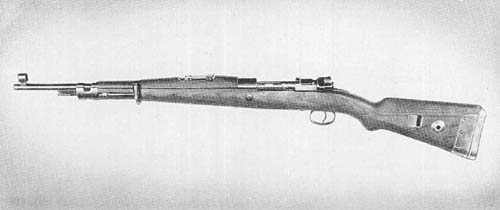

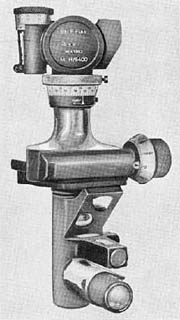 The Rbl. Flak is used with heavy antiaircraft guns for indirect fire against ground targets and for reciprocal laying. A modified type is designed for use with the predictor.
The Rbl. Flak is used with heavy antiaircraft guns for indirect fire against ground targets and for reciprocal laying. A modified type is designed for use with the predictor.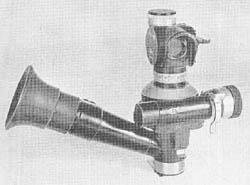 The Rundblickfernrohr 40 is believed to have been designed for use with the
The Rundblickfernrohr 40 is believed to have been designed for use with the 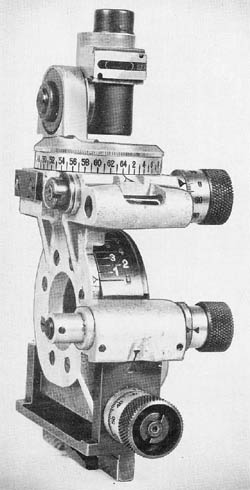 This quadrant sight is called a “substitute aiming device” by the Germans. It will fit into the sight mount found on the 7.62 cm Pak 36 (r), the 5 cm Pak 38, and the 7.5 cm Pak 40. The device has apparently been designed as a cheap instrument for indirect laying and may be used with any weapon having a suitable adapter.
This quadrant sight is called a “substitute aiming device” by the Germans. It will fit into the sight mount found on the 7.62 cm Pak 36 (r), the 5 cm Pak 38, and the 7.5 cm Pak 40. The device has apparently been designed as a cheap instrument for indirect laying and may be used with any weapon having a suitable adapter.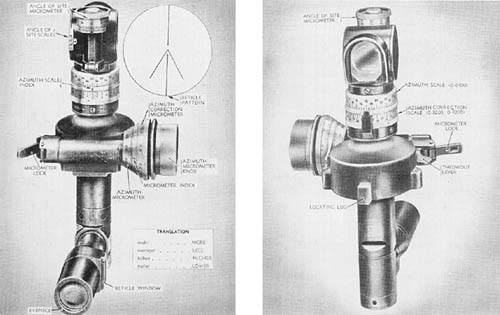
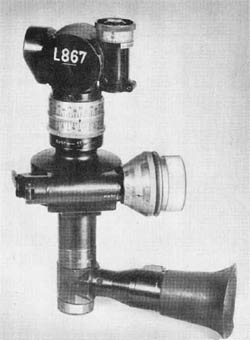 This panoramic telescope is used on all standard field equipment. It is a 4-power, fixed-focus type with a field of view of 10 degrees. The line of sight may be raised or lowered by rotation of the angle of site knob. The angle of site scale is graduated from 100 mils to 500 mils (300 mils in normal). The angle of site micrometer is graduated in mils from 0 to 100 mils. The azimuth scales on the vertical barrel of the telescope are graduated in 100-mil intervals; the upper scale, 0 to 64, is fixed in relation to the rotating head. The lower has two semi-circular scales numbered 0 to 32 and can be rotated independently of the rotating head. A knurled portion permits adjustment. The azimuth micrometer includes two scales graduated in mils from 0 to 100 mils. The outer scale can be rotated independently of the azimuth worm. Evidently the fixed azimuth scale and micrometer are used for initial laying of the piece and the second scale and micrometer are then zeroed and used to measure base deflection. A throw-out lever is provided for rapid setting in azimuth. A locking lever locks the azimuth micrometer in any setting. The reticle pattern is shown above.
This panoramic telescope is used on all standard field equipment. It is a 4-power, fixed-focus type with a field of view of 10 degrees. The line of sight may be raised or lowered by rotation of the angle of site knob. The angle of site scale is graduated from 100 mils to 500 mils (300 mils in normal). The angle of site micrometer is graduated in mils from 0 to 100 mils. The azimuth scales on the vertical barrel of the telescope are graduated in 100-mil intervals; the upper scale, 0 to 64, is fixed in relation to the rotating head. The lower has two semi-circular scales numbered 0 to 32 and can be rotated independently of the rotating head. A knurled portion permits adjustment. The azimuth micrometer includes two scales graduated in mils from 0 to 100 mils. The outer scale can be rotated independently of the azimuth worm. Evidently the fixed azimuth scale and micrometer are used for initial laying of the piece and the second scale and micrometer are then zeroed and used to measure base deflection. A throw-out lever is provided for rapid setting in azimuth. A locking lever locks the azimuth micrometer in any setting. The reticle pattern is shown above.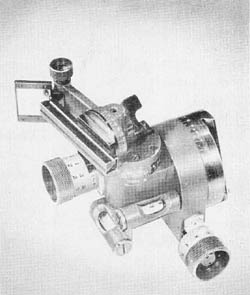 This instrument is designed to be used for laying the German 81 mm Mortar in azimuth and elevation. It embodies means for obtaining right or left lateral deflection, elevation or depression, and a collimator sight for sighting on an aiming point.
This instrument is designed to be used for laying the German 81 mm Mortar in azimuth and elevation. It embodies means for obtaining right or left lateral deflection, elevation or depression, and a collimator sight for sighting on an aiming point.